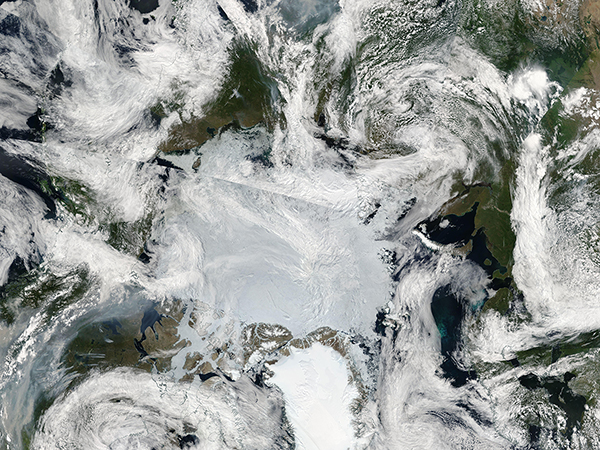Images
July 18, 2023 - Wildfire Smoke Surrounds the Arctic
Tweet
A vicious Northern Hemisphere wildfire season continued through mid-July 2023, with hundreds of large fires in Eastern Russia and Canada pumping smoke into the atmosphere. Through the spring and summer, this smoke has hung over many millions of people across the Northern Hemisphere, turning sunsets red, skies gray, and even forcing people to shelter indoors or wear masks in an attempt to escape dangerous air quality.
These effects are not just happening next to the fire-stricken areas, but throughout the Northern Hemisphere. For example, wave after wave of smoke has funneled southward from Canada to spread over the United States, driving AQI (Air Quality Index) into the Red (“unhealthy”), purple (“very unhealthy”) and even maroon (“hazardous”) categories. On July 17, Canadian smoke funneled as far south as Birmingham, Alabama, where AQI at 10:00 p.m. local time was at 153 (Red). Forecasters expect additional smoke to funnel southward on July 18, bringing decreased visibility and poor air quality to more than 70 million U.S. residents.
But smoke also funnels northward.
On July 13, 2023, the Moderate Resolution Imaging Spectroradiometer (MODIS) acquired a gorgeous true-color image of the Arctic. Swirls of clouds surround the sea ice covering the Arctic Ocean, and the dull white sea ice also covers the waters around Canada’s Queen Anne Islands. Greenland’s white ice sheet shimmers brightly in the lower center of the image. All of these features are common to summer in the Arctic. But the image also contains something very uncommon—clouds of smoke.
The first gray plume can be seen entering the image in the lower left corner. This is a massive stream of smoke that has funneled northward from the fires in Western Canada, and it stretches so far north that it appears to reach the edge of the sea ice covering the Arctic Ocean. A second patch of thick smoke can is visible at the top center of the image. This gray pall originates from fires in Russia’s Far East, and does not reach as far into the Arctic Circle as the Canadian smoke. It is remarkable to view smoke originating on opposite sides of the Earth reaching into the Arctic Circle at the same time.
Image Facts
Satellite:
Aqua
Date Acquired: 7/13/2023
Resolutions:
1km (7.6 MB), 500m ( B), 250m ( B)
Bands Used: 1,4,3
Image Credit:
MODIS Land Rapid Response Team, NASA GSFC
Tweet
A vicious Northern Hemisphere wildfire season continued through mid-July 2023, with hundreds of large fires in Eastern Russia and Canada pumping smoke into the atmosphere. Through the spring and summer, this smoke has hung over many millions of people across the Northern Hemisphere, turning sunsets red, skies gray, and even forcing people to shelter indoors or wear masks in an attempt to escape dangerous air quality.
These effects are not just happening next to the fire-stricken areas, but throughout the Northern Hemisphere. For example, wave after wave of smoke has funneled southward from Canada to spread over the United States, driving AQI (Air Quality Index) into the Red (“unhealthy”), purple (“very unhealthy”) and even maroon (“hazardous”) categories. On July 17, Canadian smoke funneled as far south as Birmingham, Alabama, where AQI at 10:00 p.m. local time was at 153 (Red). Forecasters expect additional smoke to funnel southward on July 18, bringing decreased visibility and poor air quality to more than 70 million U.S. residents.
But smoke also funnels northward.
On July 13, 2023, the Moderate Resolution Imaging Spectroradiometer (MODIS) acquired a gorgeous true-color image of the Arctic. Swirls of clouds surround the sea ice covering the Arctic Ocean, and the dull white sea ice also covers the waters around Canada’s Queen Anne Islands. Greenland’s white ice sheet shimmers brightly in the lower center of the image. All of these features are common to summer in the Arctic. But the image also contains something very uncommon—clouds of smoke.
The first gray plume can be seen entering the image in the lower left corner. This is a massive stream of smoke that has funneled northward from the fires in Western Canada, and it stretches so far north that it appears to reach the edge of the sea ice covering the Arctic Ocean. A second patch of thick smoke can is visible at the top center of the image. This gray pall originates from fires in Russia’s Far East, and does not reach as far into the Arctic Circle as the Canadian smoke. It is remarkable to view smoke originating on opposite sides of the Earth reaching into the Arctic Circle at the same time.
Image Facts
Satellite:
Aqua
Date Acquired: 7/13/2023
Resolutions:
1km (7.6 MB), 500m ( B), 250m ( B)
Bands Used: 1,4,3
Image Credit:
MODIS Land Rapid Response Team, NASA GSFC




